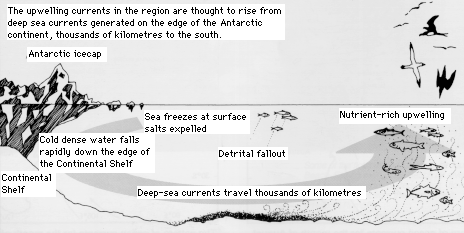|
"The open sea in the tropics, in contrast to temperate and arctic seas, is generally low in nutrients and dissolved oxygen, and hence marine life. However, deep beneath the circulating surface currents there are 'rivers' of cold dense water which at various points rise to the surface. The rich supply of nutrients these cold 'upwellings' carry to the surface enable a profusion of minute plants, phytoplankton, to grow. These in turn sustain an abundance of other organisms in the marine food chain, creating a virtual 'oasis' in what is otherwise a marine desert. "These upwellings are as yet not well understood. They are believed to originate in the southern oceans, on the edges of the Antarctic continent, during the winter freezing of the surrounding sea. As ice forms at the surface, salts are expelled, the water below becomes more dense, and falls down the slopes of the continental shelf. The current thus generated pushes out deep into the ocean, even as far as the equator, eventually rising to the surface as cool upwellings rich in dissolved nutrients gathered on their way, particularly nitrates and phosphates from the detrital fall-out on the ocean floor. "These periodical upwellings create rich fishing grounds off the west coast of Africa, and off the west coast of South America they support many millions of seabirds, leading to the accumulations of 'guano islands' there. "Such currents have been detected 200 - 300 kilometres north-west of Christmas Island and have proved to be important in the overall ecology of the region, particularly for the seabird populations which breed on the island." Reference: Christmas Island - Naturally, 2nd edition 1995. Christmas Island Natural History Association.
|
This text is accompanied by a figure, reproduced below:
 |